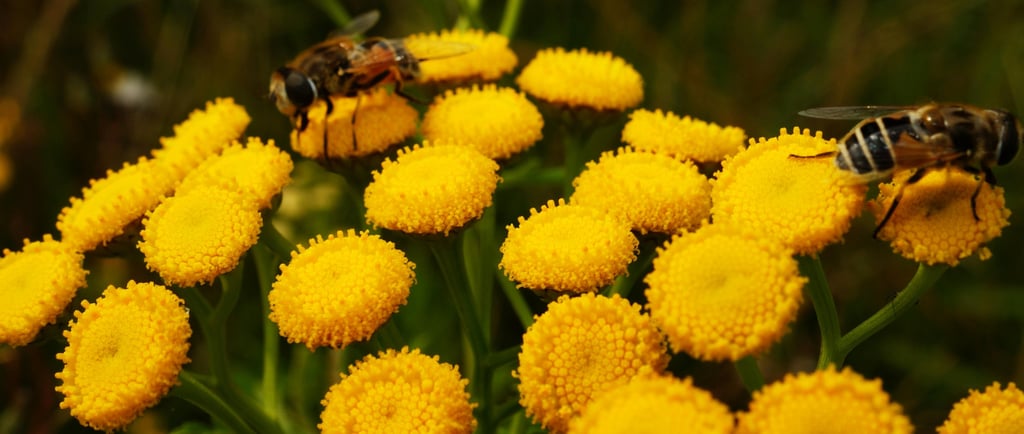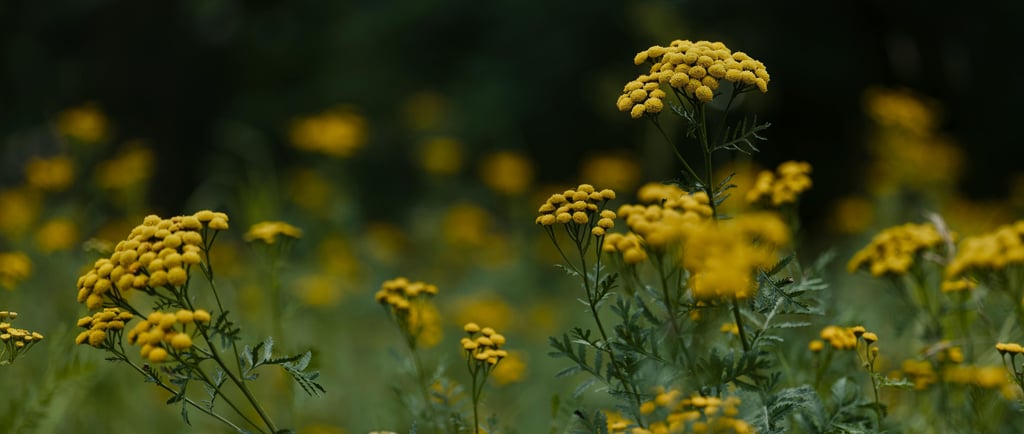Tansy (Tanacetum vulgare) – A Herb of Protection and Purification
Explore Tansy (Tanacetum vulgare) – a bitter wild herb once sacred in folk medicine. A story of cleansing, protection, and herbal strength.
PLANT WISDOM JOURNAL
Sigita Gyva


Tansy (Tanacetum vulgare)
When late summer paints the meadows with tall plants crowned by bright yellow, button-like blossoms, few pause to consider they’re looking at a plant once revered as powerful medicine. Tansy, or Tanacetum vulgare, may now be dismissed as a weed, but not long ago it was a mainstay of the home apothecary. Its strong scent and bitter taste once guarded the body from invaders within and without, stirred stagnation, and softened various discomforts. A plant that commands respect – and offers true strength in return.
Tansy’s Traditional Herbal Qualities
Tansy is one of those herbs that works on many levels – physical and energetic alike. Traditionally, it was used to regulate uterine Qi, bring harmony to a woman’s cycle, and ease menstrual discomfort, especially where pain was tied to stagnation, internal cold, or blocked pelvic flow.
It dissolves tension, dispels internal wind, and eases spasms – making it helpful not only for digestive concerns, but also for muscle cramps, period pains, or intestinal spasms. Its cooling, sweat-inducing nature made it useful during fevers, especially when the body struggled to break a sweat and felt both heated and stuck at once.
Its bitterness and bile-activating qualities make Tansy a steadfast ally to the digestive system – it stimulates appetite, supports liver function, breaks down damp phlegm, and eases bloating and sluggish elimination.
In traditional medicine, it was also widely used for its antiparasitic effects – helping to expel pinworms, roundworms, and other internal parasites. Additionally, it has mild diuretic properties that encourage the release of fluids and reduce swelling, especially when linked to stagnation or excess dampness.
Thanks to its anti-inflammatory action, Tansy was applied externally to reduce swelling, support wound healing, soothe skin irritation, and calm insect bites. It strengthens the skin barrier and aids in the repair of damaged tissue.
This is a plant that cleanses, mobilizes, liberates – while holding the body's delicate balance with care. Used with mindfulness and respect, Tansy becomes a valuable natural ally for detox, energy flow, and feminine rhythm. In large doses or over prolonged periods, it can be toxic – so its use must be intentional and measured.


Tansy in Traditional Herbalism
Tansy was used in many ways across folk traditions. It was a go-to herb for childhood bellyaches, fevers, and worm infestations. Mothers and grandmothers brewed its bitter tea to cleanse the gut and encourage sweating. After a few days, the child’s eyes would brighten, their belly calm, and their dreams would ease.
Sprigs of Tansy were hung above doors or beds – to ward off the “evil eye,” illness, or even energetic depletion. Dried flower heads were tucked into cupboards against moths, while its infusions were applied topically for itching, insect bites, or inflamed skin. To keep Tansy growing near the homestead meant staying alert – not only to illness, but also to stagnant energy.
Preparation & Forms of Use
The medicinal part of Tansy is the flower head, harvested in full bloom – typically late July or August. It’s best gathered on a sunny day when the plant is rich in essential oils. Dry in shade with good airflow to preserve its color and strong scent.
Tea (infusion)
Pour 1 teaspoon of dried flower heads with a cup of boiling water. Cover and steep for ~10 minutes, then strain. Drink ½ cup 1–2 times daily, no longer than 4–5 consecutive days.
Tincture
Use a 1:5 ratio of flower heads to 40–50% alcohol. Let steep in a dark place for 2–3 weeks, shaking daily. Take 10–15 drops in water, 1–2 times a day, only for short durations and under professional guidance.
External use
Tansy can be used as a wash or compress for itchy skin, eczema, wounds, and inflamed joints. The decoction may also help soothe dandruff or itchy scalp.
Caution: Due to the toxicity of thujone, Tansy should not be used by pregnant individuals, small children, or those with liver or nervous system disorders. Not for long-term use.
Energetics & Constitutional Guidance
Energetically, Tansy is warming, drying, and activating. It stirs cold, sluggish systems, awakens digestive fire, and clears dampness and phlegm. This energy benefits those who feel heavy, slow, or bogged down – both physically and emotionally.
By constitutional type:
Kapha types benefit most – especially those prone to dampness, mucus, and stagnation.
Vata types may use it if cold and damp dominate, but only with balancing, warming herbs.
Pitta types should approach with caution, as Tansy can provoke heat.
Here’s what Nicholas Culpeper wrote of Tansy:
“Lady Venus, the ruler of this plant, took joy in gifting it to women with child, for no herb better suits their needs. It halts miscarriage when placed on the navel – none else does this so well. Steeped in ale and taken as a decoction, it strengthens the womb and restores its tone. Women who long for children, love this herb – it is your best friend, next to your husband.
It dissolves phlegmatic humours from winter’s chill, and this is why it was among the first greens eaten in spring. Tansy decoction or juice, taken with wine, aids all urinary afflictions and helps with kidney weakness. It dispels gas in the belly, aids menstruation, and soothes bruised wombs when applied to the lower abdomen.
Roasted with eggs (as done in springtime), it supports digestion and drives out what is harmful to the gut. The seeds are good for worms in children. Infused in oil, it soothes cramped and cold-stricken muscles.”


Bitterness in the Kitchen
Though rarely used in cooking today, Tansy once held a place in celebratory cakes and herbal brews. Its bold bitterness added depth to gingerbreads, pastries, and liqueurs – supporting digestion after feasting. In a pinch, its dried flowers could even stand in for black pepper.
To explore its flavor, try infusing a few dried blossoms into honey syrup or including it in a bitter liqueur base. But use it very sparingly. With potent herbs, less is more.
A Strong, Bitter Ally
Tansy bridges old-world wisdom with modern need – for clarity, resilience, and the reclamation of personal strength. A natural product that, when used with care, can aid digestion, detox, parasite prevention, or even act as a natural repellent.
But this is not an everyday herb – Tansy requires focus, intention, and responsibility.
To bring it back into your home apothecary is to also bring back reverence for the plant world – where what matters isn’t quantity, but consciousness.
Disclaimer & Holistic Responsibility Statement
At Manua, we honor the deep roots of ancestral plant wisdom. Every offering shared on this platform reflects traditional herbal knowledge and our own lived experience with nature's remedies. However, it is essential to approach wellness with discernment and personal responsibility.
Our products and content are not intended to diagnose, treat, cure, or prevent any disease.
All descriptions, including uses and benefits, are provided for educational and informational purposes only, and are based on traditional uses, folk practices, and naturalist perspectives.
This offering is not a substitute for professional medical advice, diagnosis, or treatment. We do not make medical claims and we do not encourage replacing prescribed care with herbal preparations.
We strongly encourage each individual to make health decisions with intention – guided by multiple sources of information, personal experience, and the support of a trusted healthcare provider. Always consult with your physician, naturopath, or clinical herbalist if you are pregnant, breastfeeding, taking medications, or navigating a specific health condition.
Nature’s path is personal. Trust your intuition. Listen to your body. Seek wisdom where it aligns with your truth.
Gather with us in the wild web
Living closer to nature, through learning and presence.
Letters from the Wild
© 2025. All rights reserved.
